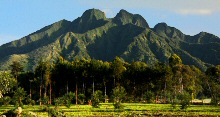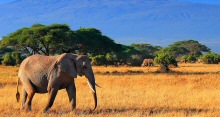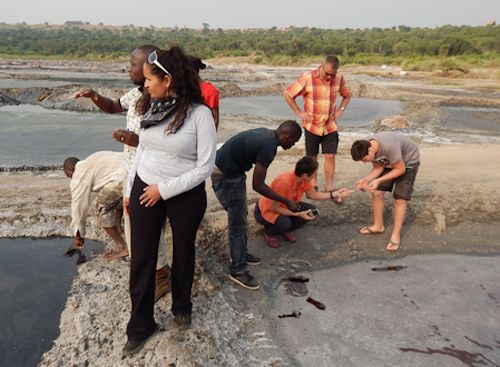 Lake Katwe is located in western Uganda-Kasese district about 550 kilometers from Kampala. This lake is one of the 52 explosion crater lakes located in Queen Elizabeth National Park and it is a very resourceful lake since it is the source of almost all the salt that is consumed in Uganda. This lake was formed after a powerful volcanic eruption that happened more than 10,000 years ago. This lake is like 9km wide and about 6 feet deep.
Lake Katwe is located in western Uganda-Kasese district about 550 kilometers from Kampala. This lake is one of the 52 explosion crater lakes located in Queen Elizabeth National Park and it is a very resourceful lake since it is the source of almost all the salt that is consumed in Uganda. This lake was formed after a powerful volcanic eruption that happened more than 10,000 years ago. This lake is like 9km wide and about 6 feet deep.
The lake has unique divisions, smaller and in square shape and they are called salt pans. The pans measure about nine feet wide and then two meters deep and it is from these pans that salt is got after it collects there. There are moments when the salt has to be dug out of the mud using hoes and all they have to do is demarcate where they are mining from thereby creating the pan. Richardson Ouma who is also a miner at Katwe Tourism Information Centre said that there are over 1000 pans however according to sources, it is evident that 800 pans are registered by the Katwe Town Council therefore the others are operating illegally.
Challenges faced by the miners
This mine is not only a source of salt but also black mud which is also called Trona, this black-mud is converted into a very good fertilizer used on farms in Kenya and also when making glass. Much as it is great source of income, it poses a great health risk to them something unfortunately they are bluntly ignoring it because of the urge to earn money.
The effect to men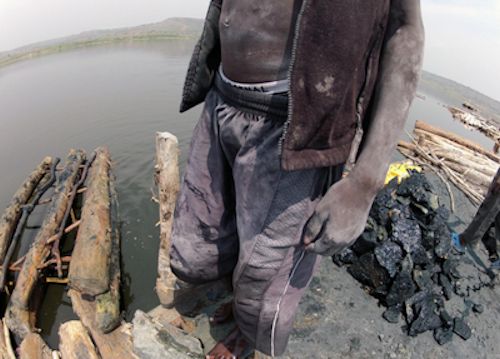
One of the workers at the lake confirms that this salty water cause their reproductive parts to itch and once they scratch for purposes of relief, tiny tiny sore develop which widen with time to become wound. The fact that they can’t afford the protective gears, they often wear condoms which they fasten with rubber bands so they don’t slip off to keep them from slipping off and that way, you will be safe.
The effect to women
In the case of the women, they get exposed to that ammonia gas which comes from the water and once it enters their reproductive organs, they suffer a uterus irritation which brings about the abdominal pains. What they do is to heavily pad themselves before they go into the salt pans, they use cotton and pieces of clothes since they can afford the real pads.
Others challenges faced include the fact that they have to spend long hours bending the lake which in the long run cause them back aches. With all these problems, Smile Power Foundation a company from Seattle, Washington is one of the companies that have come out to help these people. They provided the men with protective gears but they abandoned after a very short time because they really very hot and uncomfortable to wear while working under that hot sun.
Aside from salt mining, this lake attracts tourist and other travelers in Uganda for other reasons too like researcher and this lake can be visited any time of the year. Probably you can choose the less busy months in year when there is no congestion like the case is high seasons. High seasons kick in from June to August and also mid October to December. You need to be in company of your guide and will have to pay a fee at Katwe Tourism Information Centre before you go visit the lake.
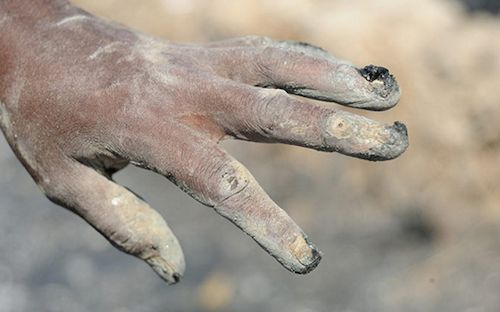 Organized Salt Tours
Organized Salt Tours
Usually, both the local and foreign tourists visit this lake to witness how the salt is locally extracted and purified. You should not expect to see any animals because the water is way too salty for any animals to survive in it therefore the main purpose of this lake is to support the Katwe villagers as they spend long hours of the day under the hot sun trying to harvest salt from the water.
Close to the lake are exclusive networks of paths as well as huts which were built to provide shelter to hundreds of workers. At the end of the day, they sell the rock and some table salt to a bunch of traders who come from different parts of Uganda and in D.R. Congo as well as Rwanda. This business is the main source of income for so many communities around the lake.
A trip to Lake Katwe will give you a perfect insight into this really interesting though very tough mining process and yet a great alternative source of income. During this tour, you will get to see the local people at work, you will have to walk and cross the mud walkways, then enter any of those traditional grass thatched houses which they use as shelter and store units for their tools.
This tour usually takes 2 hours but there is always room for flexibility which means you can always have more time with these miners if you wish to.
Other places you can visit aside from the lake is the bird sanctuary which is located just close by, this sanctuary is a home to thousands of bird species which include the flamingos which are often seen in plenty from the month of October to May.
The Cost of Salt Pans
Often, everyone is responsible for their own pans and it is not common that one can sell from another one’s. The price for a pan is goes between shs 800,000 to 2,000,000 depending on the size of the pan. These pans are inherited from one family member to another which is how they have been able to protect the lake from being destroyed, it is the same reason why no more pans can be dug there.
There are a salt-tolerant plant species at the shores of this lake 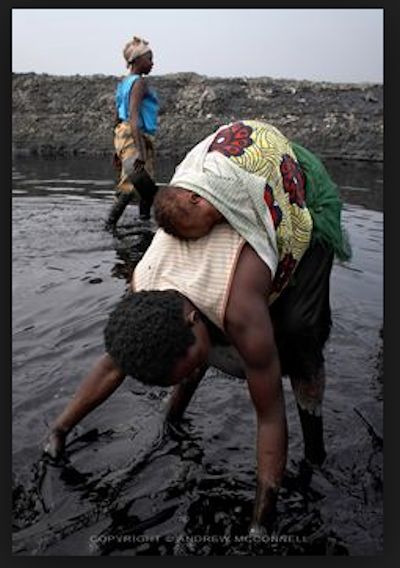 and these help in conserving the lake by filtering out all the impurities for example the sediments out of the blowing wind as well as rain water that flows from the hills in the surrounding areas. The grass around the lake prevents and regulates the amount of impurities that gets into the lake but unfortunately the locals are at the same time cutting g down the papyrus so they can get the raw material for their the swamps for making mats.
and these help in conserving the lake by filtering out all the impurities for example the sediments out of the blowing wind as well as rain water that flows from the hills in the surrounding areas. The grass around the lake prevents and regulates the amount of impurities that gets into the lake but unfortunately the locals are at the same time cutting g down the papyrus so they can get the raw material for their the swamps for making mats.
At the mining areas, there are mainly two salt mining activities that go one at the lake and that includes the rock salt mining and salt winning. The rock salt mining is mainly done in Katwe main lake and it is done by only the men while salt winning is done in those small salt pans by the men and women. That salt that is got from the pans is formed by fractional crystallization process. The salt crystals that are formed are then scrapped from the bottom of the water using the curved iron but this normally done during the dry season and its ready for human use. The only difference with the one sold in the shops is that they have bigger crystals and it has less iodine in it. It costs a bit less compared to the one in the shops because 1 sack of 100kgs costs Shs 40, 000 only.
The Rock mining which is done in the main lake is a lot more complicated because the main sodium chloride rock is right underneath the water body. This kind of salt is the kind that is locally called the Ekisula and it forms right at the bottom of this lake by cementation. The biggest market comes from Rwanda and Congo.
Purposes of the rock salt include;
The rock salt is used for different purposes which include acting as a catalyst when boiling the dry beans.
It is also keeps the hides and skins from rotting. Farmers feed to the animals to increase on the amount of milk produced especially in cows.
It is very useful when dyeing clothes too and also used during the process of saponification when making soap. 100kgs of this rock salt cost only Shs20,000.
Where to stay – Accommodation
During your visit, you can spend a night in any of the hotels located close by for example the luxury Mweya Safari Lodge; there is Ihamba safari lodge both located in Queen Elizabeth National Park. There are other hotels in Kasese town like Executive Inn and Silver Springs Hotel, among others.
For more information about Lake Katwe, please visit http://www.adventureugandasafari.com/

